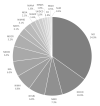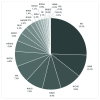Health Literacy Research Funded by the NIH for Disease Prevention
- PMID: 33170287
- PMCID: PMC8330440
- DOI: 10.3928/24748307-20200928-01
Health Literacy Research Funded by the NIH for Disease Prevention
Abstract
Background: Advancing health literacy is a fundamental step toward achieving population health. To that end, the National Institutes of Health (NIH) funded research to increase scientific understanding of how health literacy can reduce disparities and enhance the health of the United States.
Objective: This study identified and evaluated NIH-funded health literacy research focusing on disease prevention.
Methods: New R01, R03, and R21 research project grants awarded from fiscal year (FY) 2004 to FY 2017 studying health literacy and disease prevention were identified. Study characteristics, including the role of health literacy, how health literacy was measured, populations studied, and study design, were coded for each grant. Administrative grant data were obtained from the NIH's internal database. Research impact was assessed using the relative citation ratio (RCR).
Key results: There were 192 grants studying health literacy and disease prevention awarded by 18 NIH institutes and centers from FY 2004 to FY 2017, covering a wide variety of health conditions including cancer (26.0%), infectious diseases (13.5%), nutrition (8.3%), drug/alcohol use (7.8%), and cardiovascular disease (6.3%). Most grants studied the health literacy skills of patients (88%), with a few studies assessing the health literacy practices of health care providers (2.1%) or systems (1%). There was good representation of populations with traditionally low levels of health literacy, including Black/African American participants (30.2%), Hispanic/Latinx participants (28.6%), older adults (37%), and people with low income (20.8%). The scientific articles generated by these grants were more than twice (RCR = 2.18) as influential on the field as similar articles.
Conclusions: The NIH provided support for a wide array of prevention-focused health literacy research. The value of this research is highlighted by the number of funding institutes and centers, the diversity of populations and health conditions studied, and the effect these grants had on the field. Future research should move beyond patient-level health literacy to health literacy practices of health care systems and providers. [HLRP: Health Literacy Research and Practice. 2020, 4(4):e212-e223.] PLAIN LANGUAGE SUMMARY: This study describes health literacy research funded by the National Institutes of Health that focused on disease prevention. These grants sought to prevent a variety of health conditions, but health literacy research over the past 14 years continued to concentrate on the capacity of patients despite increased attention on the health literacy practices of health care providers and systems.
©2020 Villani, Trivedi.
Figures





Comment in
-
A Direction for the Next Decade of NIH-Funded Health Literacy Research.Health Lit Res Pract. 2020 Nov 6;4(4):e208-e211. doi: 10.3928/24748307-20200923-01. Health Lit Res Pract. 2020. PMID: 33170286 Free PMC article. No abstract available.
References
-
- Brach C. Keller D. Hernandez L. M. Baur C. Dreyer B. Schyve P. Schillinger D. (2012). Ten attributes of health literate health care organizations. Retrieved from National Academy of Medicine website: https://nam.edu/perspectives-2012-ten-attributes-of-health-literate-heal...
MeSH terms
LinkOut - more resources
Full Text Sources
Medical
Miscellaneous

